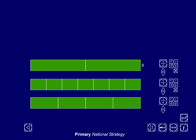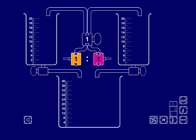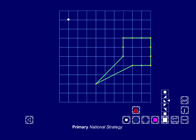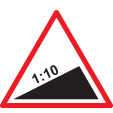Teaching guidance
This teaching guidance document suggests some of the key vocabulary, models, images and practical equipment that children should experience and be able to use. It also includes some teaching tips to provide a few starting points for ways of supporting children with this area of mathematics.
 Teaching guidance: Can I explain and use ratio notation? | 52KB
Teaching guidance: Can I explain and use ratio notation? | 52KB 
Consolidation and practice
These resources are to support children in guided or independent work. Roll over the highlighted resources for a description.
Fractions

The Fractions interactive teaching program (ITP) is an ICT-based tool to support the exploration of part numbers. Fractions ITP allows the child or teacher to represent and compare fractions on fraction strips. The displayed strips can be labelled as a vulgar fraction, a decimal (to three decimal places) or a percentage, and the ratio of yellow to green parts of each strip can also be displayed.
Ratio and proportion

This interactive teaching program (ITP) is an ICT-based tool to support the exploration of number. Ratio and proportion ITP allows the child or teacher to represent and combine two different liquids in a chosen ratio.
Area

The Area interactive teaching program (ITP) is an ICT-based tool to support the exploration of number, shape and space and problem solving. Area ITP (version 2.2) allows the child or teacher to place counters or colour in whole or part cells on a grid, pinboard or blank screen, or to define a shape using a rubber band.
Opportunities to use and apply
Possible contexts include:
- Geography, e.g. interpreting the scale on maps and plans.
- Design technology or art, e.g. recording the scale that has been used to create models or drawings.
- Interpreting signs in everyday life, e.g. drawing a diagram to explain the meaning of a 1:10 incline.

- Exploring important mathematical ratios, e.g. The Golden Ratio; Pi.
Confirming learning
Ask probing questions such as:
-
Which of these ratios are equivalent to 5:20?
- 4:1
- 2:8
- 6:21
- 1:4
- 10:25
Now give some more ratios that are equivalent to 5:20, justifying your suggestions.
- A one-metre piece of ribbon is cut into two pieces. One piece is 65 cm long. Write the ratio of the length of the shorter piece to the length of the longer piece in its simplest form.
- Describe the relationship between the area of the purple shape and the area of the blue shape using the language and notation of ratio.

-
One-fifth of the children in Class 6 go home for lunch; the rest stay in school. Which of these ratios represents the number of children who go home compared to the number of children who stay in school? Justify your choice.
- 1:5
- 5:1
- 1:4
- 4:1


 Counting and understanding number and associated objectives
Counting and understanding number and associated objectives




